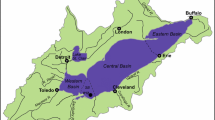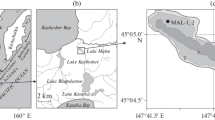Abstract
A 9000cal. year record of geochemistry was analysed in a sediment core obtained from a Swiss alpine hard-water lake (1937 ma.s.l.) that is located at the present-day tree-line. Geochemical stratigraphies are compared to changes in mineralogy, grain-size, pollen, and macrofossil records. This allows the reconstruction of the effects of changes in vegetation and of 3500 years of land-use in the catchment area on sediment geochemistry. Using principal component analysis, two major geochemical groups are distinguished: (i) Changes in concentrations of Rb, Ti, Zr, Fe, As, and Pb are closely related to corresponding changes in the concentrations of quartz and clay. They are thus considered to represent the silicate fraction which shows an increase from the oldest to the youngest core section. (ii) In contrast, Ca and Sr concentrations are positively correlated with changes in silt, sand, and calcite. They are therefore considered to represent the carbonate fraction which gradually decreased. Based on constrained cluster analysis, the core is divided into two major zones. The oldest zone (A; 9000–6400 cal.BP) is characterised by high concentrations of detrital carbonates. The more open catchment vegetation at that time promoted the physical weathering of these carbonates. The second major zone (B, 6400 cal.BP–1996 AD) is divided into four subsections with boundaries at ca. 3500, 2400, and 160cal. BP. The lower part of this zone, B1, is characterized by a gradual decrease in the carbonate-silt fraction and a pronounced increase in the silicate-clay fraction. This is concurrent with the expansion of Picea in the catchment area, which probably stabilized the soil. The middle part, B2 and B3 (3500–160cal. BP), comprises pronounced fluctuations in all elements, especially Ca, Sr, Mn, and Rb, but also in clay and silt. These changes are related to varying intensities of alpine farming. In the same section, Mn/Fe ratios are highly variable, suggesting changes in the mixing regime of the lake with phases of anoxic bottom water. The uppermost section, B4 (since 160cal. BP), is characterized by a steep decline in the silicate fraction and an increase in Ca and Sr. Despite the decrease in the silicate fraction, Pb increases, due to elevated atmospheric input resulting from early metal pollution, are masked by the high natural variability. Generally, changes in vegetation, which correspond to climate changes in the early Holocene and to human activities since ca. 3700cal. BP, are the controlling factor for variations in the geochemical composition of the sediment of Sägistalsee.
Similar content being viewed by others
References
Bennett K.D. 1996. Determination of the number of zones in a biostratigraphical sequence. New Phytol. 132: 155–170.
Blais J.M. and Kalff J. 1993. Atmospheric loading of Zn, Cu, Ni, Cr, and Pb to lake-sediments — the role of catchment, lake morphometry, and physicochemical properties of the elements. Biogeochemistry 23: 1–22.
Boyle J.F. 2000. Rapid elemental analysis of sediment samples by isotope source XRF. J. Paleolim. 23: 213–221.
Brännvall M.L., Bindler R., Emteryd O. and Renberg I. 2001. Four thousand years of atmospheric lead pollution in Northern Europe: a summary from Swedish lake sediments. J. Paleolim. 25: 421–435.
Brännvall M.L., Bindler R., Renberg I., Emteryd O., Bartnicki J. and Billstrom K. 1999. The Medieval metal industry was the cradle of modern large scale atmospheric lead pollution in northern Europe. Envir. Sci. Technol. 33: 4391–4395.
Brenner M., Whitmore T.J., Curtis J.H., Hodell D.A. and Schelske C.L. 1999. Stable isotope (delta C-13 and delta N-15) signatures of sedimented organic matter as indicators of historic lake trophic state. J. Paleolim. 22: 205–221.
Camarero L., Masque P., Devos W., Ani Ragolta I., Catalan J., Moor H.C., Pla S. and Sanchez Cabeza J.A. 1998. Historical variations in lead fluxes in the Pyrenees (northeast Spain) from a dated lake sediment core. Wat. Air. Soil Pollut. 105: 439–449.
Cheburkin A.K., Frei R. and Shotyk W. 1997. An Energy-Dispersive Miniprobe Multielement Analyzer (EMMA) for direct analysis of trace-elements and chemical age dating of single mineral grains. Chem. Geol. 135: 75–87.
Cheburkin A.K. and Shotyk W. 1996. An Energy-Dispersive Miniprobe Multielement Analyzer (EMMA) for direct analysis of Pb and other trace-elements in peats. Fresenius. J. Anal. Chem. 354: 688–691.
Davison W. 1993. Iron and manganese in lakes. Earth Sci. Rev. 34: 119–163.
Dean W.E. 1999. The carbon cycle and biogeochemical dynamics in lake sediments. J. Paleolim. 21: 375–393.
Engstrom D.R., Swain E.B. and Kingston J.C. 1985. A palaeolimnological record of human disturbance from Harvey's Lake, Vermont: geochemistry, pigments and diatoms. Freshwat. Biol. 15: 261–288.
Francis D.R. 2001. A record of hypolimnetic oxygen conditions in a temperate multi-depression lake from chemical evidence and Chironomid remains. J. Paleolim. 25: 351–365.
Heiri O. and Lotter A.F. 2003. 9000 years of chironomid assemblage dynamics in an Alpine lake: long-term trends, sensitivity to disturbance of resilience of the fauna. J. Paleolim. 30: 273–289.
Hirt A.M., Lanci L. and Koinig K.A. 2003. Mineral magnetic record of Holocene environmental changes in Sägistalsee, Switzerland. J. Paleolim. 30: 321–331
Hofmann W. 2003. The long-term succession of high-altitude cladoceran assemblages: a 9000 year record from Sägistalsee (Swiss Alps, 1935 m asl). J. Paleolim. 30: 291–296
Kauppila T. and Salonen V.-P. 1997. The effect of Holocene treeline fluctuations on the sediment chemistry of Lake Kilpisjärvi, Finland. J. Paleolim. 18: 145–163.
Lamb H.F., Roberts N., Leng M., Barker P., Benkaddour A. and Van Der Kaars S. 1999. Lake evolution in a semi-arid mountain environment: Response to catchment change and hydroclimatic variation. J. Paleolim. 21: 325–343.
Legendre P. and Legendre L. 1998. Numerical Ecology. Elsevier, Amsterdam, 853 pp.
Lotter A.F. 2001. The palaeolimnology of Soppensee (Central Switzerland), as evidenced by diatom, pollen, and fossil-pigment analyses. J. Paleolim. 25: 65–79.
Lotter A.F. and Birks H.J.B. 2003. Holocene sediments of Sägistalsee, a small lake at present-day tree-line in the Swiss Alps. J. Paleolim. 30: 253–260
Norton S.A., Bienert R.W., Bienford M.W. and Kahl J.S. 1992. Stratigraphy of total metals in PIRLA sediment cores. J. Paleolim. 7: 191–214.
Norton S.A. and Kahl J.S. 1991. Progress in understanding the chemical stratigraphy of metals in lake-sediments in relation to acidic precipitation. Hydrobiologia 214: 77–84.
Ohlendorf C., Sturm M. and Hausmann S. 2003. Natural environmental changes and human impact reflected in sediments of a high alpine lake in Switzerland. J. Paleolim. 30: 297–306
Quinlan R. and Smol J.P. 2001. Setting minimum head capsule abundance and taxa deletion criteria in chironomid-based inference models. J. Paleolim. 26: 327–342.
Quinlan R., Smol J.P. and Hall R.I. 1998. Quantitative inferences of past hypolimnetic anoxia in south-central Ontario lakes using fossil midges (Diptera: Chironomidae). Can. J. Fish. aquat. Sci. 55: 587–596.
Renberg I., Wik-Persson M. and Emteryd O. 1994. Pre-industrial atmospheric lead contamination detected in Swedish lake sediments. Nature 368: 323–326.
Schwalb A., Burns S.J. and Kelts K. 1999. Holocene environments from stable isotope stratigraphy of ostracods and authigenic carbonate in Chilean Altiplano lakes. Palaeogeo. Palaeoclim. Palaeoecol. 148: 153–168.
Shotyk W. 1996. Peat bog archives of atmospheric metal deposition: geochemical evaluation of peat profiles, natural variations in metal concentrations, and metal enrichment factors. Environmental Rev. 4: 149–183.
Shotyk W., Weiss D., Appleby P.G., Cheburkin A.K., Frei R., Gloor M., Kramers J.D., Reese S. and Van der Knaap W.O. 1998. History of atmospheric lead deposition since 12,370 C-14 yr BP from a peat bog, Jura Mountains, Switzerland.Science 281: 1635–1640.
Sommaruga-Wögrath S., Koinig K.A., Schmidt R., Sommaruga R., Tessadri R. and Psenner R. 1997. Temperature effects on the acidity of remote alpine lakes. Nature 387: 64–67.
Stevens L.R., Ito E. and Olson D.E.L. 2000. Relationship of Mn-carbonates in varved lake sediments to catchment vegetation in Big Watab Lake, MN, USA. J. Paleolim. 24: 199–211.
Stumm W. and Morgan J.J. 1996. Aquatic Chemistry. Chemical Equilibria and Rates in Natural Waters. Wiley and Sons, New York, 1022 pp.
ter Braak C.J.F. and Smilauer P. 1998. CANOCO reference manual and user's guide to Canoco for Windows: Software for Canonical Community Ordination (version 4). Microcomputer Power, Ithaca, NY, USA, 352 pp.
Teranes J.L., Mckenzie J.A., Bernasconi S.M., Lotter A.F. and Sturm M. 1999. A study of oxygen isotopic fractionation during bio-induced calcite precipitation in eutrophic Baldeggersee, Switzerland. Geochim. Cosmochim. Acta 63: 1981–1989.
Valero-Garces B.L., Laird K.R., Fritz S.C., Kelts K., Ito E. and Grimm E.C. 1997. Holocene climate in the Northern Great Plains inferred from sediment stratigraphy, stable isotopes, carbonate geochemistry, diatoms, and pollen at Moon Lake, North Dakota. Quat. Res. 48: 359–369.
Wersin P., Hohener P., Giovanoli R. and Stumm W. 1991. Early diagenetic influences on iron transformations in a fresh-water lake sediment. Chem. Geol. 90: 233–252.
Wessels M., Lenhard A., Giovanoli F. and Bollhofer A. 1995. High resolution time series of lead and zinc in sediments of Lake Constance. Aquat. Sci. 57: 291–304.
White A.F., Blum A.E., Bullen T.D., Vivit D.V., Schulz M. and Fitzpatrick J. 1999. The effect of temperature on experimental and natural chemical weathering rates of granitoid rocks. Geochim. Cosmochim. Acta 63: 3277–3291.
Wick L., van Leeuwen J.F.N., van der Knaap W.O. and Lotter A.F. 2003. Holocene vegetation development in the catchment of Sägistalsee (1935 m asl), a small lake in the Swiss Alps. J. Paleolim. 30: 261–272.
Wilmshurst J.M. 1997. The impact of human settlement on vegetation and soil stability in Hawke's Bay, New Zealand. New. Zeal. J. Bot. 35: 97–111.
Wolfe A.P. and Hartling J.W. 1997. Early Holocene trace-metal enrichment in organic lake-sediments, Baffin-Island, Arctic Canada. Arct. Alp. Res. 29: 24–31.
Author information
Authors and Affiliations
Rights and permissions
About this article
Cite this article
Koinig, K.A., Shotyk, W., Lotter, A.F. et al. 9000 years of geochemical evolution of lithogenic major and trace elements in the sediment of an alpine lake – the role of climate, vegetation, and land-use history. Journal of Paleolimnology 30, 307–320 (2003). https://doi.org/10.1023/A:1026080712312
Issue Date:
DOI: https://doi.org/10.1023/A:1026080712312




